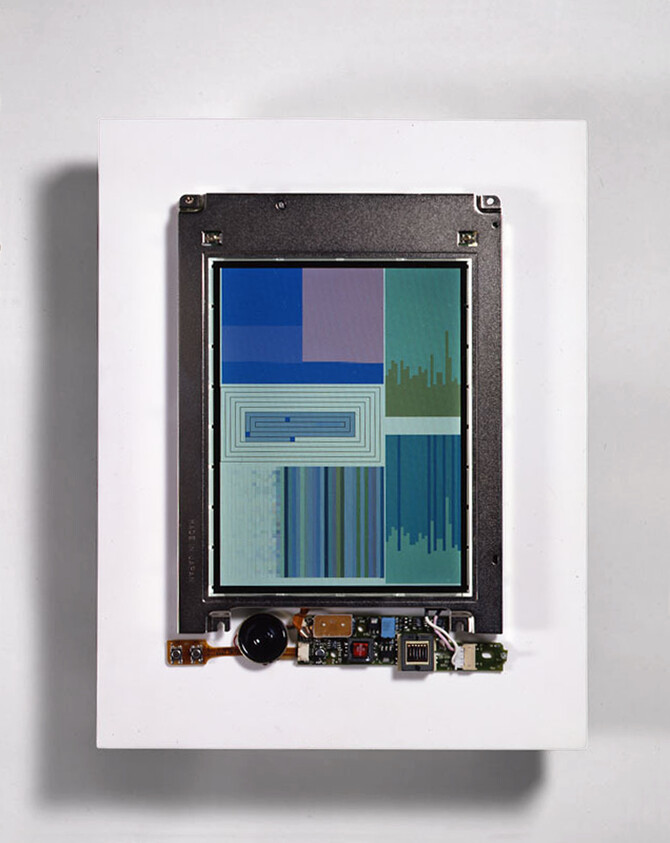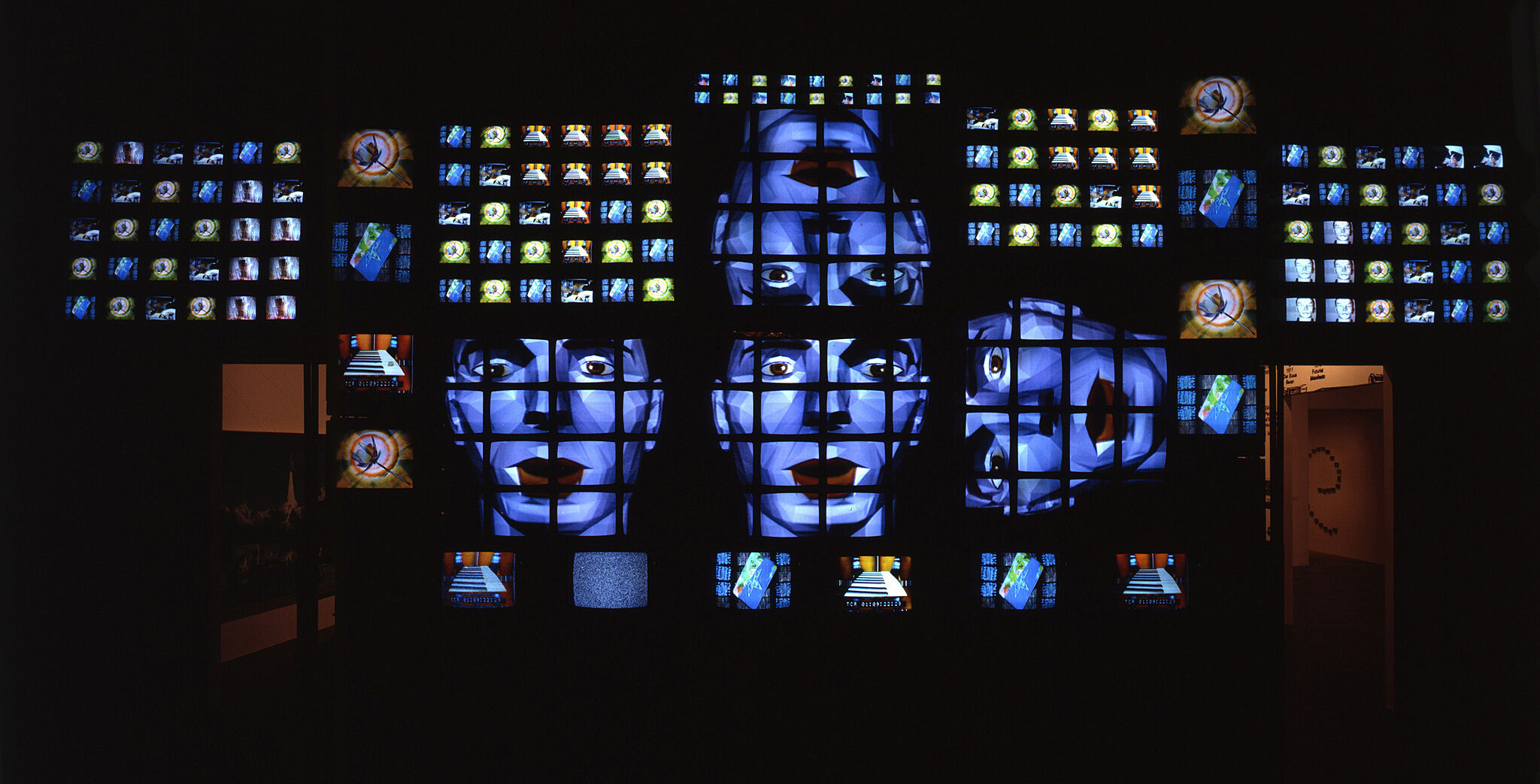Displayed on a flat-panel computer screen, Color Panel v1.0 is an artwork in the form of a computer program. The software, which John Simon wrote himself, “controls the screen, draws the composition, picks the colors, moves the colors,” producing constantly evolving compositions of squares and rectangles that deliberately evoke early modernist geometric abstraction. Simon cites the influence of Johannes Itten and Josef Albers, teachers at the Bauhaus in Germany in the 1920s and 1930s, who explored the apparent changes in hue caused by placing different colors next to each other. To this phenomenon, Color Panel v1.0 adds the element of time and, crucially, of endless variation: its beginning is variable, and its sequences never repeat, progressing over a time frame that approaches eternity. v1.0 in the title stands for the first version of the software that Simon used to create the work.
Not on view
Date
1999
Classification
Digital Art
Medium
Software, modified Apple Macintosh Powerbook 280c, and acrylic (plastic)
Dimensions
Overall: 13 1/2 × 10 1/2 × 3 in. (34.3 × 26.7 × 7.6 cm)
Accession number
99.88a-c
Edition
3/12
Credit line
Purchase, with funds from the Painting and Sculpture Committee
Rights and reproductions
© 1999 John F. Simon Jr.
Audio
-
John F. Simon Jr., Color Panel v1.0, 1999
In Programmed: Rules, Codes, and Choreographies in Art, 1965–2018
0:00
John F. Simon Jr., Color Panel v1.0, 1999
0:00
John F. Simon: My name is John F. Simon, Jr.
Color Panel v1.0 was made in 1999.
I took a used Apple 280C computer. Disassembled it. Took it all to pieces. Took the case off of it, and then I reassembled it so that the screen was on the front of the panel, and the body of the computer was on the back.
I turned the screen vertically instead of horizontally, which it usually was. And then I wrote a piece of software, custom, for that display. That was my canvas, so I want to make a time-based color study. I want to make a painting that would change continually and never repeat itself. It was an experiment in dynamic painting.
It's hard to describe how little display power and computing power there was on that computer. Even the simplest electronic device today has more power than that computer did, so I was limited in what I could do.
I had a software method that I called variable expansion, so I make a simple rule, and I get that running, and it's in a small loop, which is like a paragraph in code writing. So I have a little loop that's running. Then I begin to improvise with the loop by taking the parts that are set, and turning them into variables, expanding their range, and seeing what happens.
So in the lower left hand corner of the Color Panel I had squares of different colors bouncing back and forth in a rectangle. So there were lots of choices what to do then. Do they overlap? Did they grow? Did they shrink? How do they mix? That kind of thing.
-
John F. Simon Jr., Color Panel v1.0, 1999
In Programmed: Rules, Codes, and Choreographies in Art, 1965–2018 (Spanish)
0:00
John F. Simon Jr., Color Panel v1.0, 1999
0:00
John F. Simon: Me llamo John F. Simon, Jr.
Panel de color v1.0 es una obra de 1999.
Tomé una computadora Apple 280C usada y la desarmé. Le quité todas las piezas, le quité la carcasa y luego volví a armarla toda para que la pantalla quedara en el frente del panel y el cuerpo de la computadora quedara en la parte de atrás.
Dispuse la pantalla verticalmente, en lugar de horizontalmente, como solía estar. Y luego escribí un software especial para esa computadora. Ese era mi lienzo. Lo que quería era realizar un estudio del color basado en el tiempo. Quería crear una pintura que cambiara continuamente y nunca se repitiera. Eso fue el Panel de Color. Fue un experimento de pintura dinámica.
Es difícil de escribir qué poca potencia tenía la pantalla y qué poca potencia de cálculo tenía esa computadora. Ni siquiera comparándolo con un teléfono actual. Incluso el dispositivo electrónico más sencillo de hoy en día tiene más potencia que esa computadora. Lo que podía hacer con ella tenía un límite.
Tenía un método de software al que llamé expansión variable, que me permitía crear una regla sencilla y hacerla funcionar en un pequeño bucle. Es como un párrafo escrito en código. Así que tenía este pequeño bucle funcionando y luego comencé a improvisar con el bucle tomando partes que eran fijas y convirtiéndolas en variables y expandiendo su rango para ver qué pasaba.
Así, en la esquina inferior izquierda del panel de color tenía cuadrados de distintos colores que rebotaban dentro de un rectángulo. Tenía muchas opciones de dónde elegir. ¿Se superponían? ¿Crecían? ¿Se achicaban? ¿Cómo se mezclaban? Se trataba de ese tipo de cosas.
Exhibitions
Installation photography
-
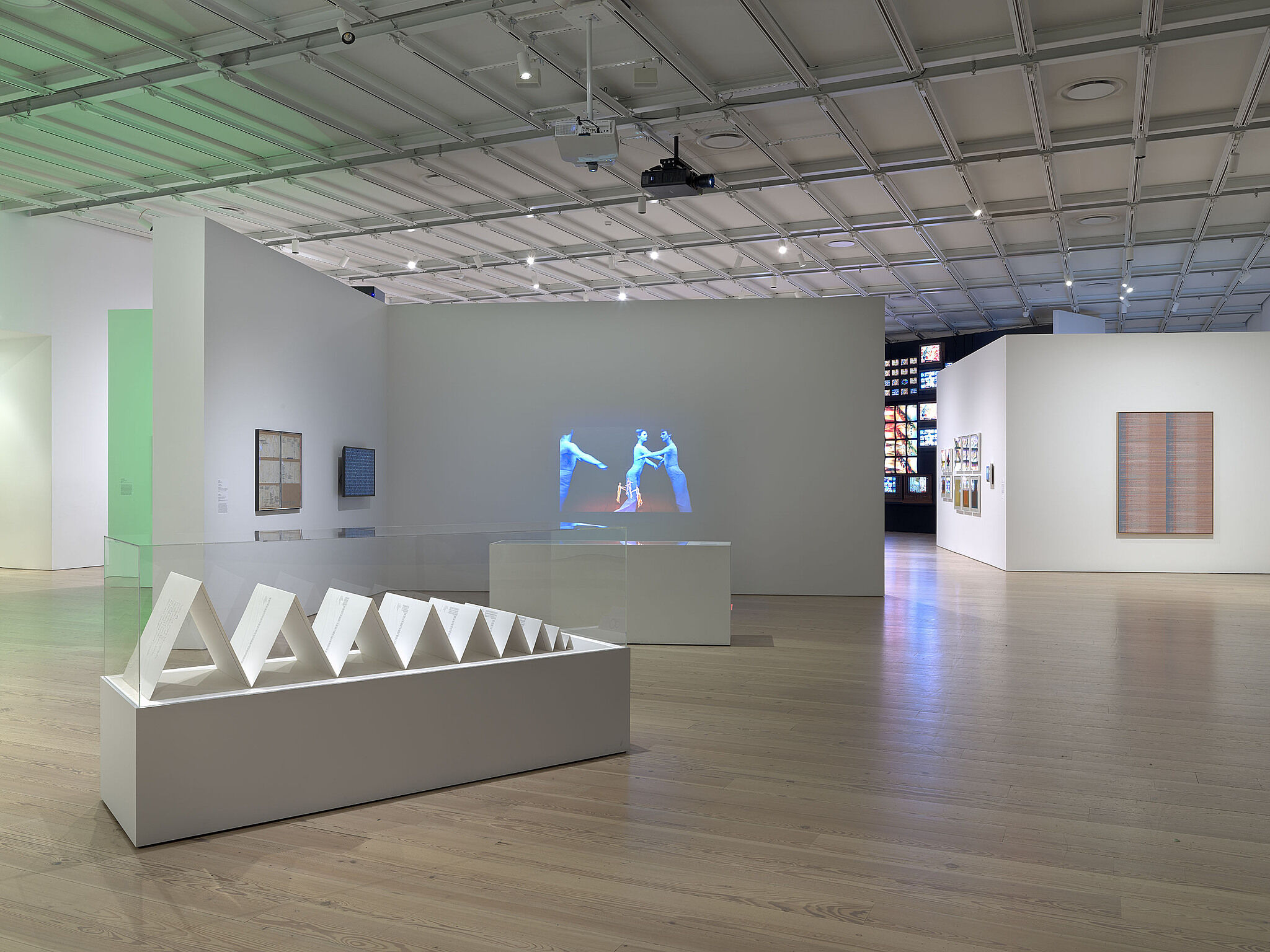

Installation view of Programmed: Rules, Codes, and Choreographies in Art, 1965–2018 (Whitney Museum of American Art, New York, September 28, 2018–April 14, 2019). From left to right: Channa Horwitz, Suite 8, 1979; Lucinda Childs and Sol LeWitt, Dance #4, 1979; Casey Reas, {Software} Structures, Sol LeWitt Wall Drawing #358, 2004 and 2016; Lucinda Childs, Philip Glass, and Sol LeWitt, Dance, 1979 and 2014; June Paik, Fin de Siècle II, 1989; Josef Albers, Variant I, 1966; Josef Albers, Variant IX, 1966; Josef Albers, Variant VIII, 1966; Josef Albers, Variant III, 1966; Josef Albers, Homage to the Square VI, 1967; Josef Albers, Homage to the Square III, 1967; Josef Albers, Homage to the Square I, 1967; Josef Albers, Homage to the Square II, 1967; Josef Albers, Homage to the Square XI, 1967; Josef Albers, Homage to the Square VII, 1967; John F. Simon Jr., Color Panel v1.0, 1999; Mika Tajima, Negative Entropy (Digital Ocean, NYC2, 4U, NAS, Pink, Quad), 2018. Photograph by Ron Amstutz
From the exhibition Programmed: Rules, Codes, and Choreographies in Art, 1965–2018
-
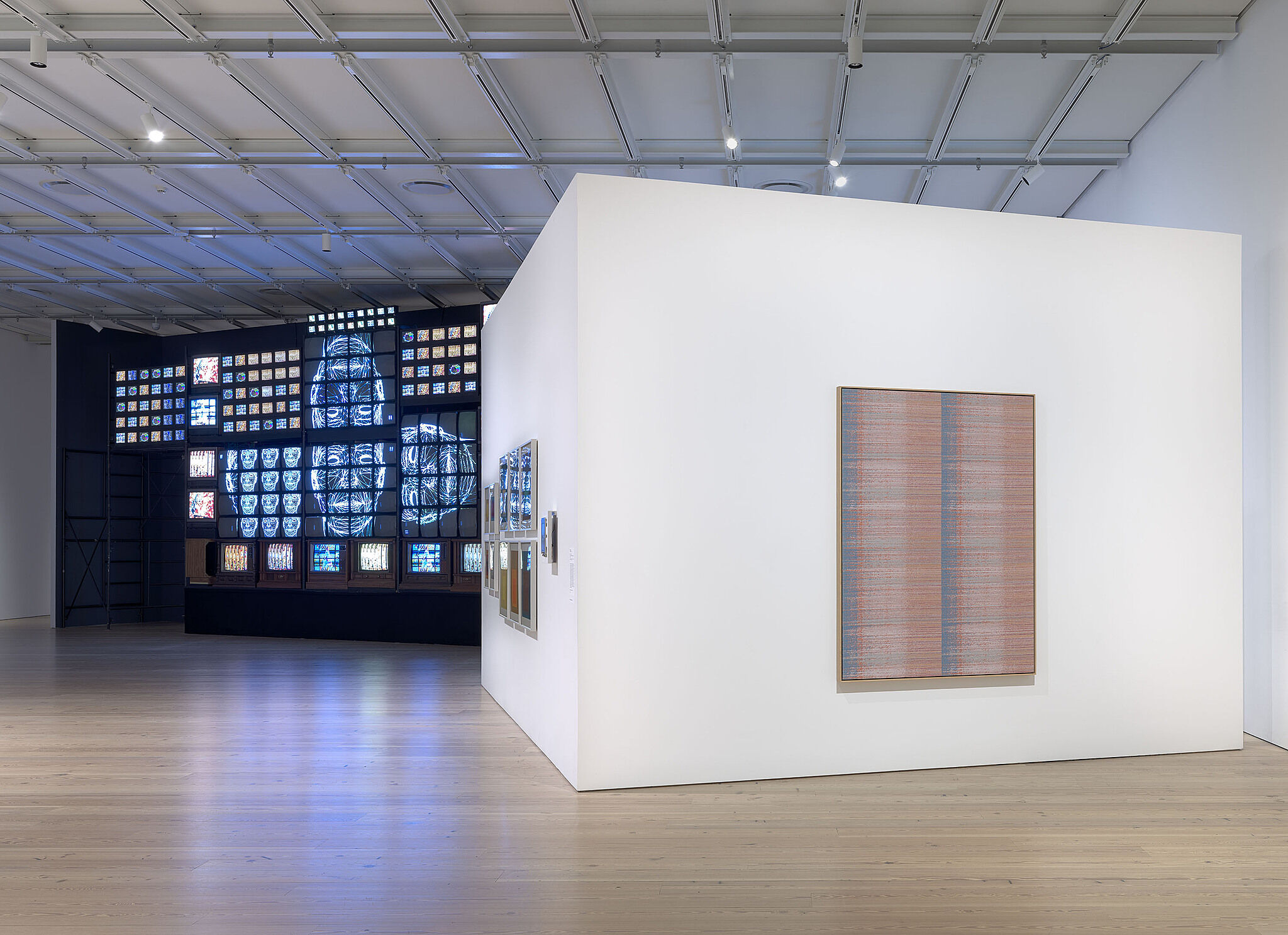

Installation view of Programmed: Rules, Codes, and Choreographies in Art, 1965–2018 (Whitney Museum of American Art, New York, September 28, 2018–April 14, 2019). From left to right, top to bottom: Nam June Paik, Fin de Siècle II, 1989; Josef Albers, Variant I, 1966; Josef Albers, Variant IX, 1966; Josef Albers, Variant VIII, 1966; Josef Albers, Variant III, 1966; Josef Albers, Homage to the Square VI, 1967; Josef Albers, Homage to the Square III, 1967; Josef Albers, Homage to the Square I, 1967; Josef Albers, Homage to the Square II, 1967; Josef Albers, Homage to the Square XI, 1967; Josef Albers, Homage to the Square VII, 1967; John F. Simon Jr., Color Panel v1.0, 1999; Mika Tajima, Negative Entropy (Digital Ocean, NYC2, 4U, NAS, Pink, Quad), 2018. Photograph by Ron Amstutz
From the exhibition Programmed: Rules, Codes, and Choreographies in Art, 1965–2018
-
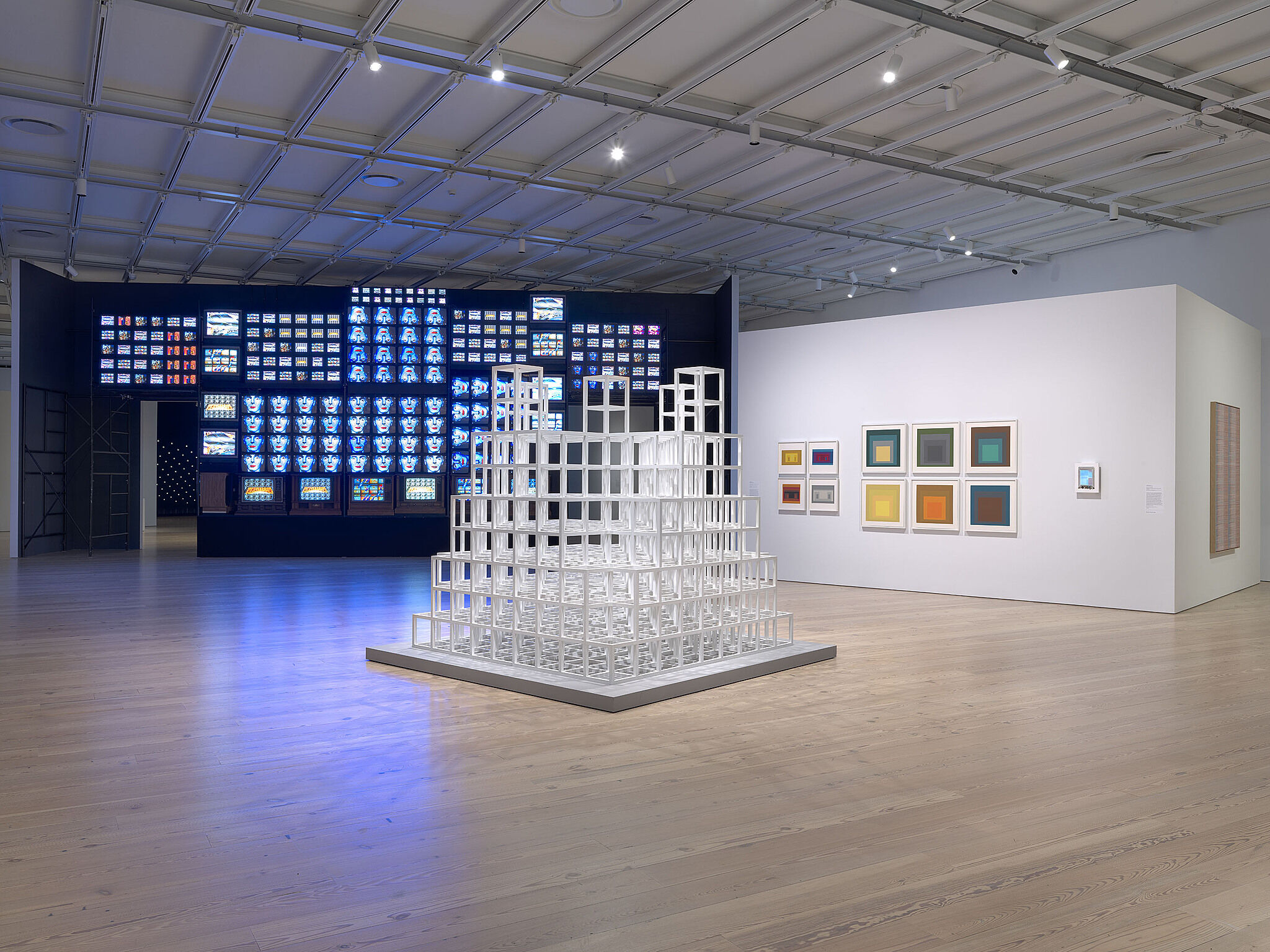

Installation view of Programmed: Rules, Codes, and Choreographies in Art, 1965–2018 (Whitney Museum of American Art, New York, September 28, 2018–April 14, 2019). From left to right, top to bottom: Nam June Paik, Fin de Siècle II, 1989; Sol Lewitt, Five Towers, 1986; Josef Albers, Variant I, 1966; Josef Albers, Variant IX, 1966; Josef Albers, Variant VIII, 1966; Josef Albers, Variant III, 1966; Josef Albers, Homage to the Square VI, 1967; Josef Albers, Homage to the Square III, 1967; Josef Albers, Homage to the Square I, 1967; Josef Albers, Homage to the Square II, 1967; Josef Albers, Homage to the Square XI, 1967; Josef Albers, Homage to the Square VII, 1967; John F. Simon Jr., Color Panel v1.0, 1999; Mika Tajima, Negative Entropy (Digital Ocean, NYC2, 4U, NAS, Pink, Quad), 2018. Photograph by Ron Amstutz
From the exhibition Programmed: Rules, Codes, and Choreographies in Art, 1965–2018
-
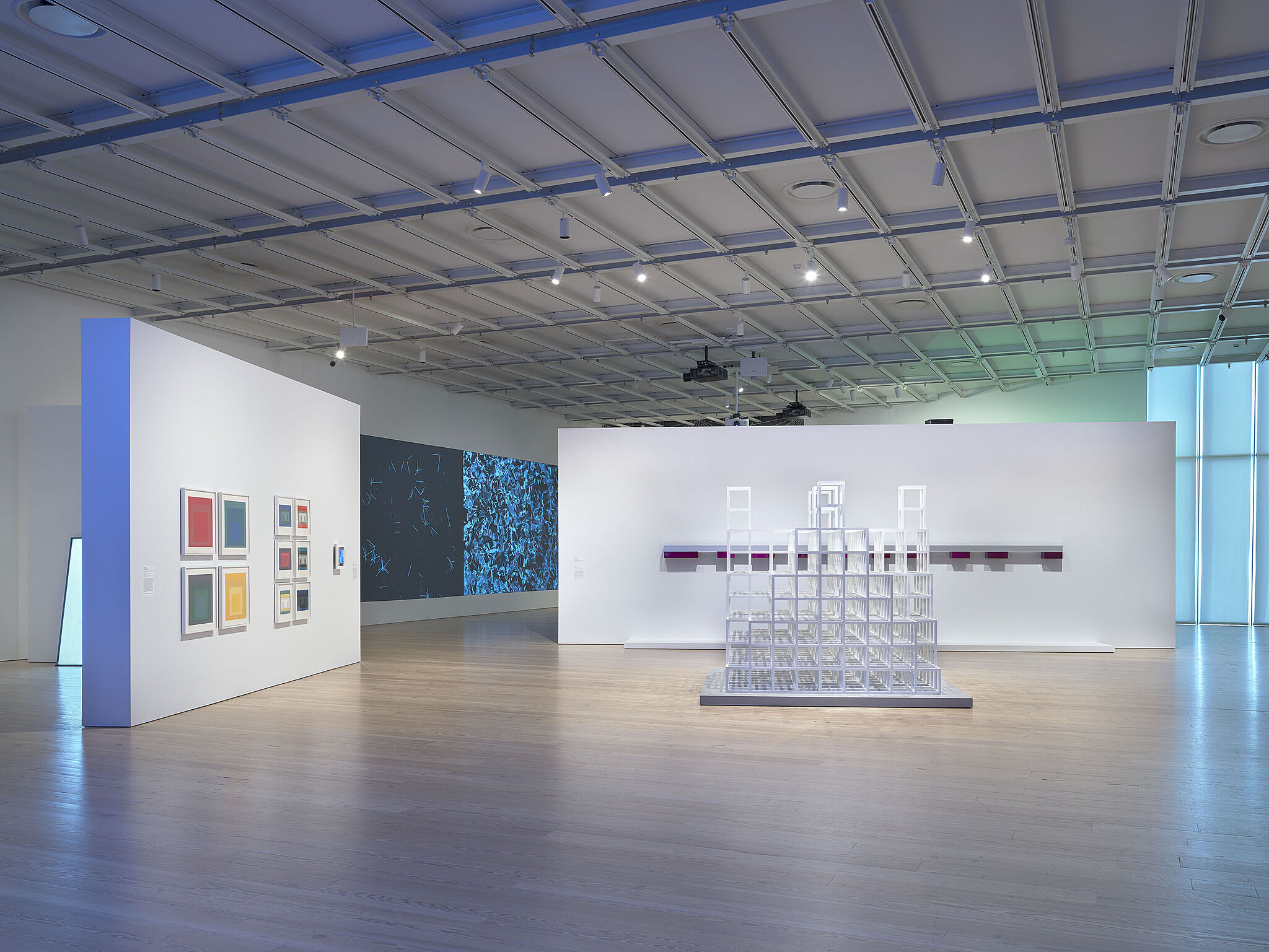

Installation view of Programmed: Rules, Codes, and Choreographies in Art, 1965–2018 (Whitney Museum of American Art, New York, September 28, 2018–April 14, 2019). From left to right, top to bottom: Ian Cheng, Baby feat. Ikaria, 2013; Josef Albers, Homage to the Square V, 1967; Josef Albers, Homage to the Square IX, 1967; Josef Albers, Homage to the Square XII, 1967; Josef Albers, Homage to the Square X, 1967; Josef Albers, Variant V, 1966; Josef Albers, Variant VI, 1966; Josef Albers, Variant X, 1966; Josef Albers, Variant IV, 1966; Josef Albers, Variant II, 1966; Josef Albers, Variant VII, 1966; John F. Simon Jr., Color Panel v1.0, 1999; Casey Reas, {Software} Structure #003 A, 2004 and 2016; Casey Reas, {Software} Structure #003 B, 2004 and 2016; Donald Judd, Untitled, 1965; Sol LeWitt, Five Towers, 1986. Photograph by Ron Amstutz
From the exhibition Programmed: Rules, Codes, and Choreographies in Art, 1965–2018
-
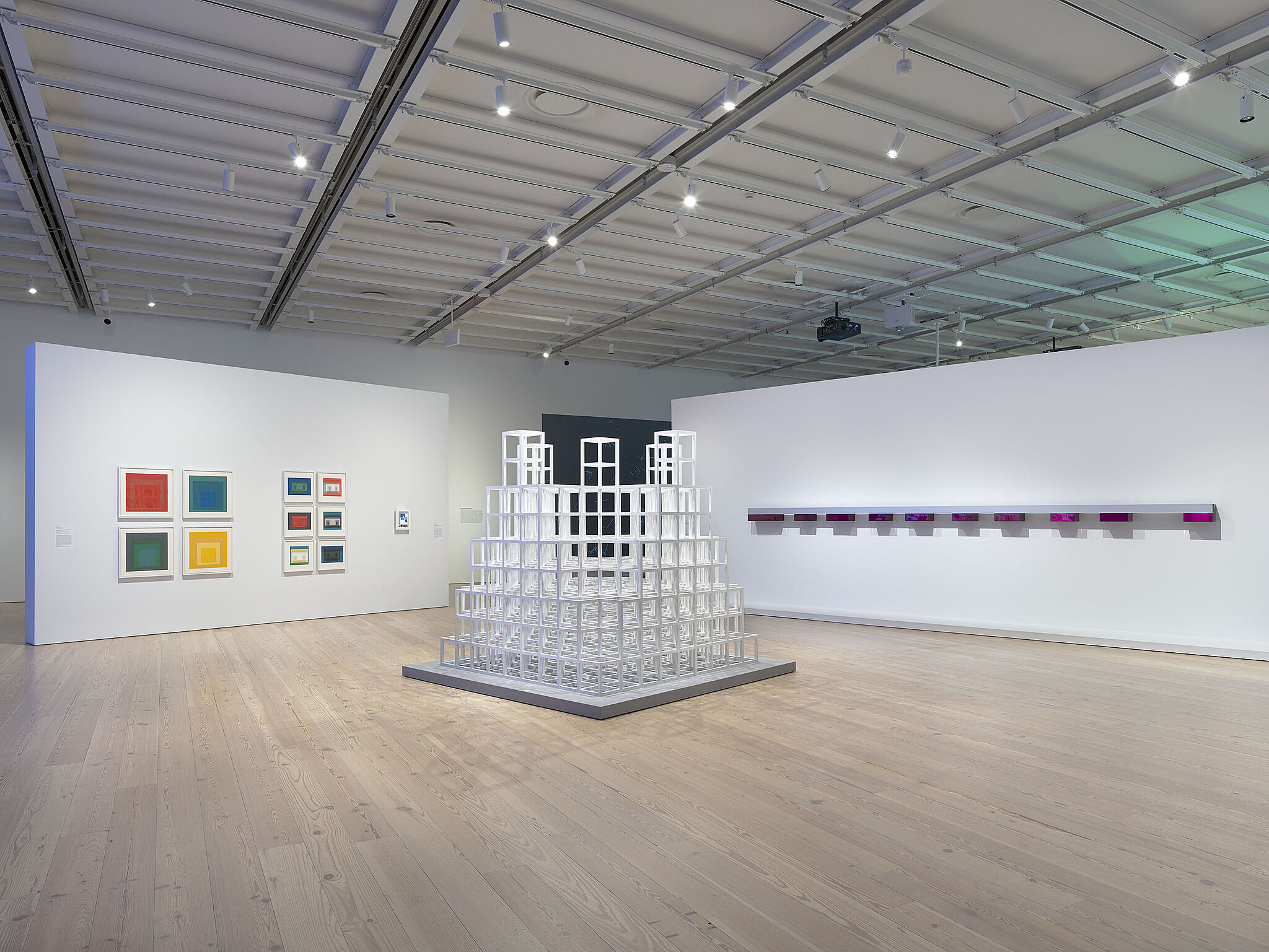

Installation view of Programmed: Rules, Codes, and Choreographies in Art, 1965–2018 (Whitney Museum of American Art, New York, September 28, 2018–April 14, 2019). From left to right, top to bottom: Josef Albers, Homage to the Square V, 1967; Josef Albers, Homage to the Square IX, 1967; Josef Albers, Homage to the Square XII, 1967; Josef Albers, Homage to the Square X, 1967; Josef Albers, Variant V, 1966; Josef Albers, Variant VI, 1966; Josef Albers, Variant X, 1966; Josef Albers, Variant IV, 1966; Josef Albers, Variant II, 1966; Josef Albers, Variant VII, 1966; John F. Simon Jr., Color Panel v1.0, 1999; Sol LeWitt, Five Towers, 1986; Casey Reas, {Software} Structure #003 A, 2004 and 2016; Donald Judd, Untitled, 1965. Photograph by Ron Amstutz
From the exhibition Programmed: Rules, Codes, and Choreographies in Art, 1965–2018
-
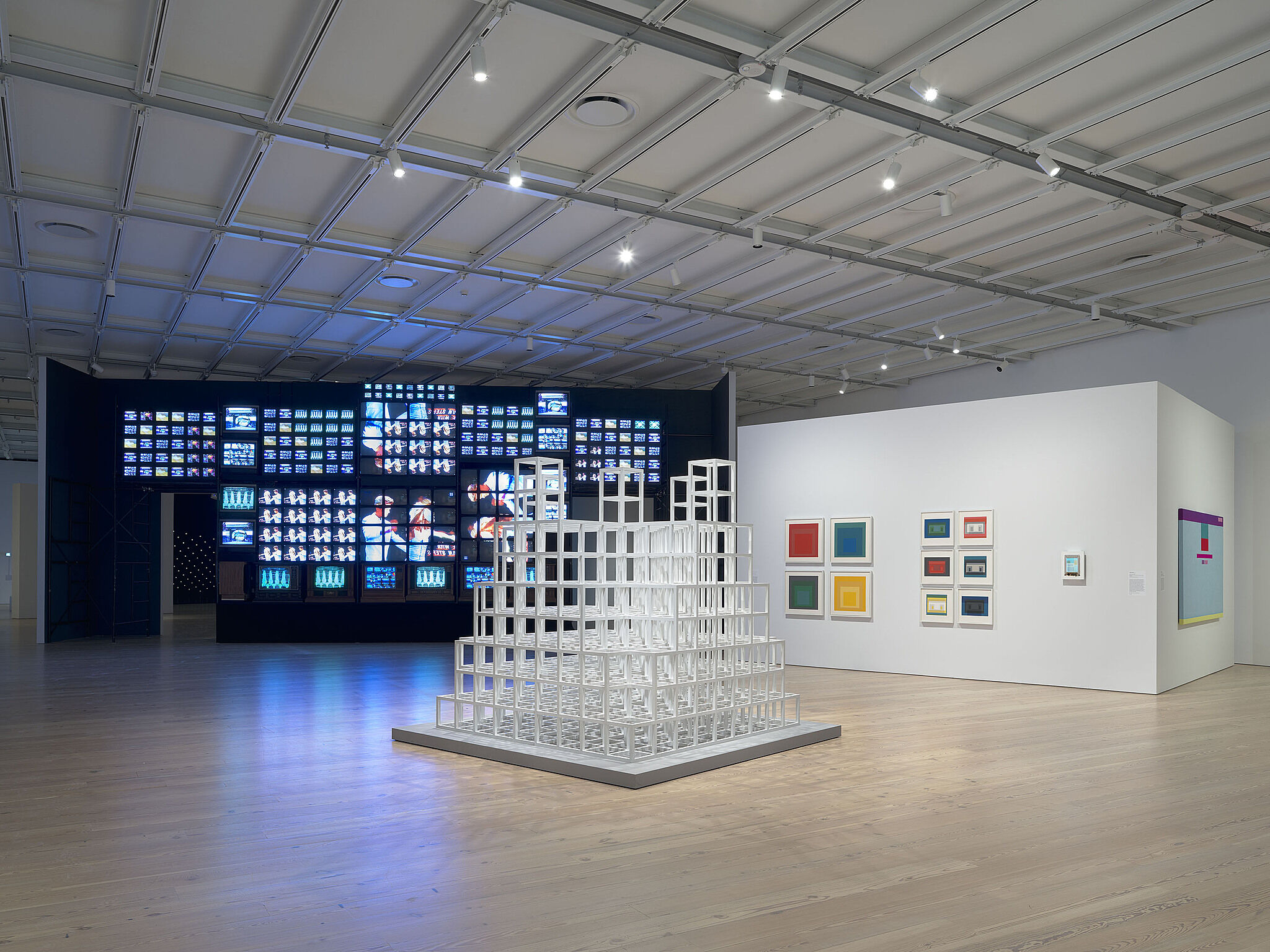

Installation view of Programmed: Rules, Codes, and Choreographies in Art, 1965–2018 (Whitney Museum of American Art, New York, September 28, 2018–April 14, 2019). From left to right: Nam June Paik, Fin de Siècle II, 1989 (partially restored, 2018); Sol LeWitt, Five Towers, 1986; Josef Albers, Homage to the Square V, 1967; Josef Albers, Homage to the Square IX, 1967; Josef Albers, Homage to the Square XII, 1967; Josef Albers, Homage to the Square X, 1967; Josef Albers, Variant V, 1966; Josef Albers, Variant VI, 1966; Josef Albers, Variant X, 1966; Josef Albers, Variant IV, 1966; Josef Albers, Variant II, 1966; Josef Albers, Variant VII, 1966; John F. Simon Jr., Color Panel v1.0, 1999; Rafaël Rozendaal, Abstract Browsing 17 03 05 (Google), 2017. Photograph by Ron Amstutz
From the exhibition Programmed: Rules, Codes, and Choreographies in Art, 1965–2018
-
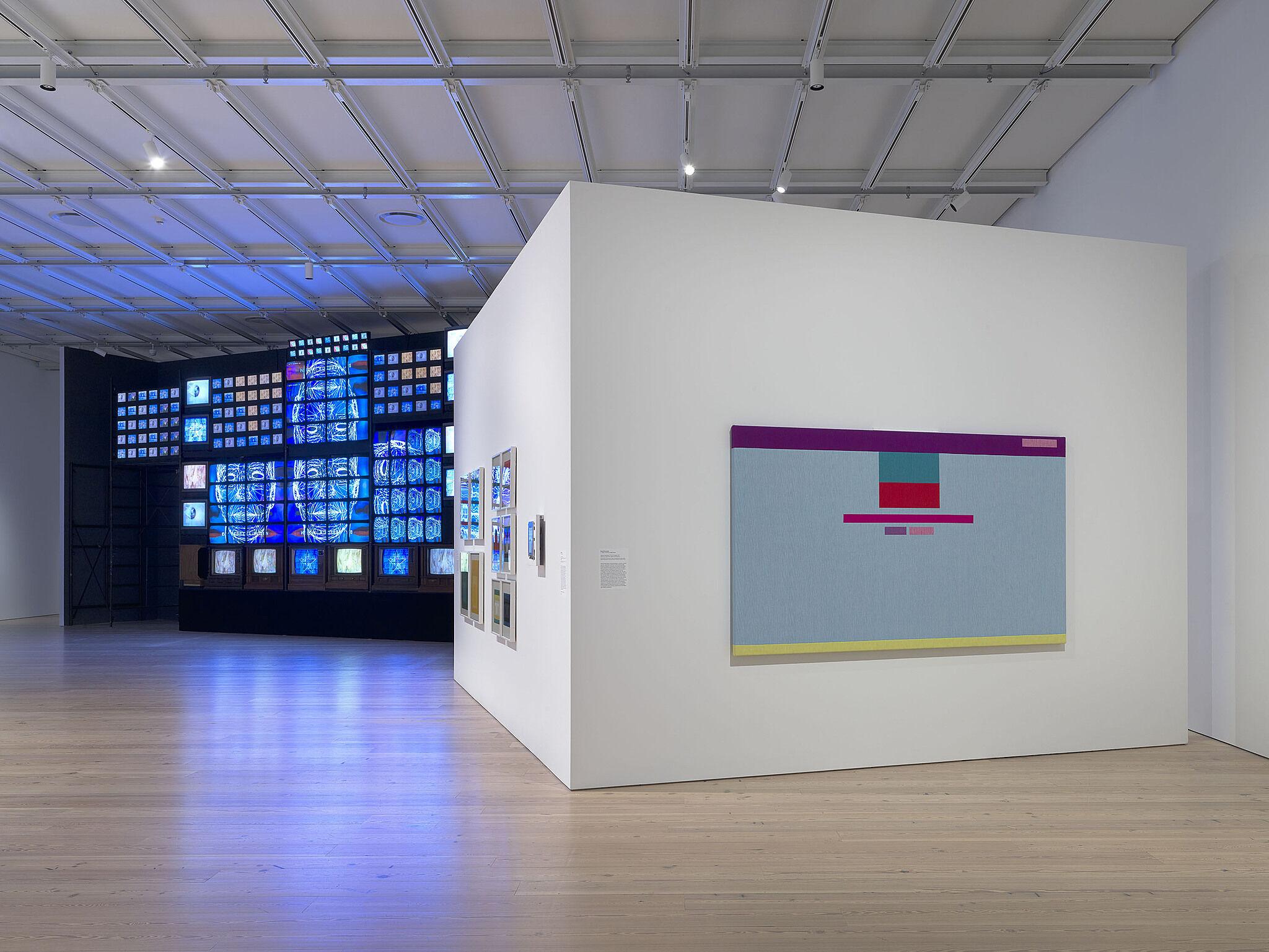

Installation view of Programmed: Rules, Codes, and Choreographies in Art, 1965–2018 (Whitney Museum of American Art, New York, September 28, 2018–April 14, 2019). From left to right, top to bottom: Nam June Paik, Fin de Siècle II, 1989 (partially restored, 2018); Josef Albers, Homage to the Square V, 1967; Josef Albers, Homage to the Square IX, 1967; Josef Albers, Homage to the Square XII, 1967; Josef Albers, Homage to the Square X, 1967; Josef Albers, Variant V, 1966; Josef Albers, Variant VI, 1966; Josef Albers, Variant X, 1966; Josef Albers, Variant IV, 1966; Josef Albers, Variant II, 1966; Josef Albers, Variant VII, 1966; John F. Simon Jr., Color Panel v1.0, 1999; Rafaël Rozendaal, Abstract Browsing 17 03 05 (Google), 2017. Photograph by Ron Amstutz
From the exhibition Programmed: Rules, Codes, and Choreographies in Art, 1965–2018
-
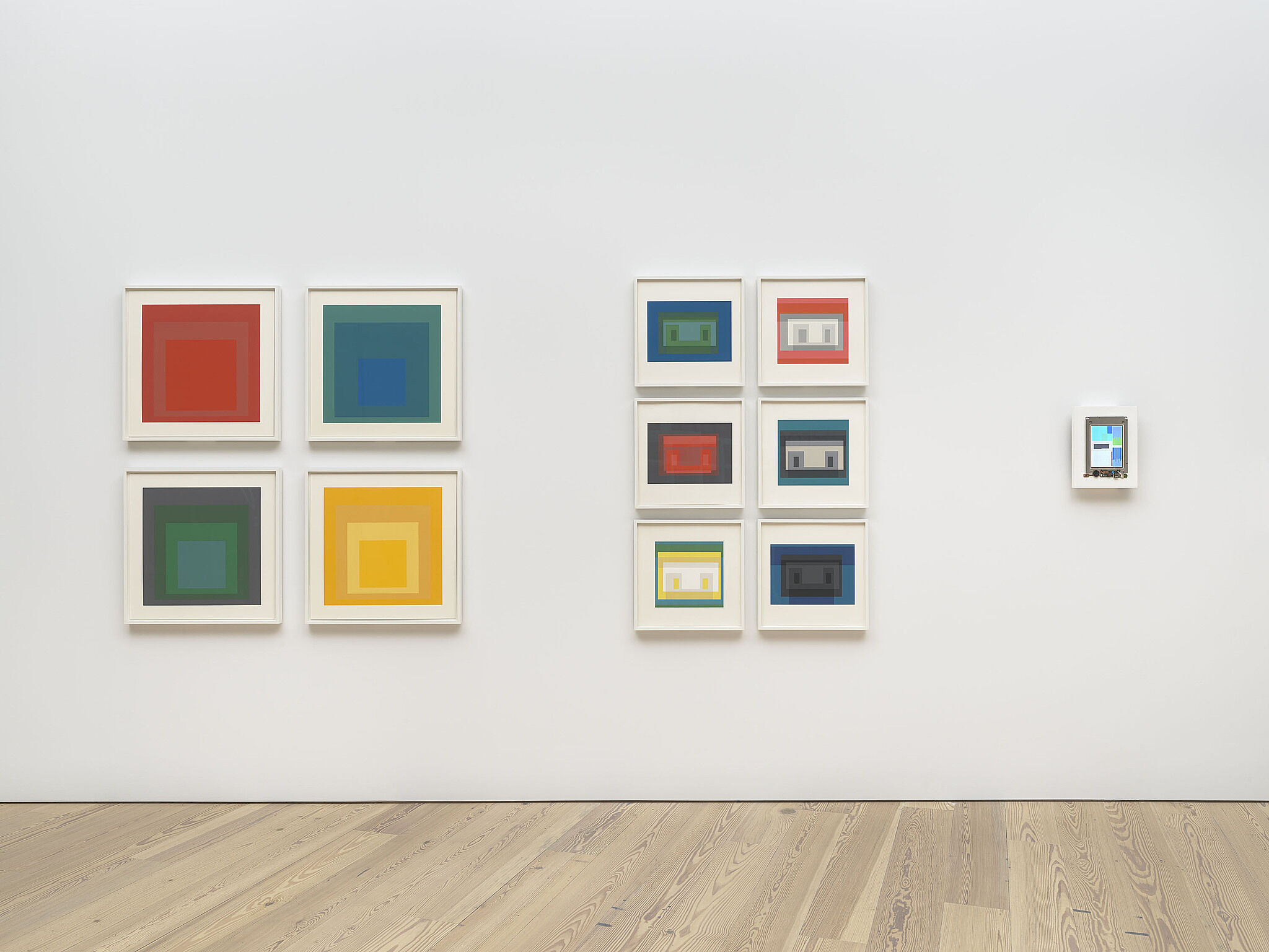

Installation view of Programmed: Rules, Codes, and Choreographies in Art, 1965–2018 (Whitney Museum of American Art, New York, September 28, 2018–April 14, 2019). From left to right, top to bottom: Josef Albers, Homage to the Square V, 1967; Josef Albers, Homage to the Square IX, 1967; Josef Albers, Homage to the Square XII, 1967; Josef Albers, Homage to the Square X, 1967; Josef Albers, Variant V, 1966; Josef Albers, Variant VI, 1966; Josef Albers, Variant X, 1966; Josef Albers, Variant IV, 1966; Josef Albers, Variant II, 1966; Josef Albers, Variant VII, 1966; John F. Simon Jr., Color Panel v1.0, 1999. Photograph by Ron Amstutz
From the exhibition Programmed: Rules, Codes, and Choreographies in Art, 1965–2018

